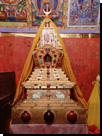Chortens
in Amdo: A
Photographic
Album
----------------------------------------------------------------------------------------------------------------------------------------
Architectural
reliquaries housing relics are known in Tibetan as chortens, and
in Sanskrit as either stupas or chaityas. In the region
of northeast ethnographic Tibet known as Amdo, there are chortens
in a variety of sizes, shapes and styles. Some are monumental and have
a huge presence in the landscape. Some are confined within the walls of
a monastery, and house the relics of famous lamas. Other small ones are
within personal shrines, or are painted on walls or ceilings. In the Buddhist
culture of Amdo, chortens are particularly prominent. Here is a
selection of chortens photographed between January and March 2002
by Rob Linrothe, mainly in and around Rongwo (Chinese: Tongren) in the
region of Amdo known as Rebgong (Chinese: Huangnan), with Dr. Linrothe's
comments. Click on each photograph to see a large version.
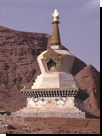 This
chorten is at the head of a valley. It announces the presence of a
monastery of the Gelugpa school of Tibetan Buddhism nearby. Farther
up the same valley are two other monasteries of both the pre-Buddhist
Bon religion and the Nyingma or "old" school of Tibetan
Buddhism. The name of the valley is Marser, and it is just south of
Rongwo. Click for details of the niche
on the anda (the large domed part of the chorten that
is likened to an upturned bowl). This
chorten is at the head of a valley. It announces the presence of a
monastery of the Gelugpa school of Tibetan Buddhism nearby. Farther
up the same valley are two other monasteries of both the pre-Buddhist
Bon religion and the Nyingma or "old" school of Tibetan
Buddhism. The name of the valley is Marser, and it is just south of
Rongwo. Click for details of the niche
on the anda (the large domed part of the chorten that
is likened to an upturned bowl). |
|||||||||||
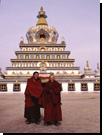 Two
monks from Rongwo Gompa in front of the Dinkur Chorten at Guomar monastery
near Rongwo (Tongren) in Rebgong. Enshrined inside the topmost cella
(shrine chamber) are robes worn by the previous Panchen Lama. Two
monks from Rongwo Gompa in front of the Dinkur Chorten at Guomar monastery
near Rongwo (Tongren) in Rebgong. Enshrined inside the topmost cella
(shrine chamber) are robes worn by the previous Panchen Lama. |
|||||||||||
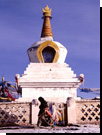 This
is a large chorten situated above the village of Zeku, a trading post
and administrative center for the nomads in the region south west
of Rebgong. A photographic image of the late Panchen Lama is in the
niche. Click for a detail of kora
(circumambulation) in the early morning. This
is a large chorten situated above the village of Zeku, a trading post
and administrative center for the nomads in the region south west
of Rebgong. A photographic image of the late Panchen Lama is in the
niche. Click for a detail of kora
(circumambulation) in the early morning. |
|||||||||||
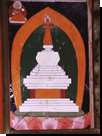 This
chorten was painted onto the ceiling of the Sanzen Lhakang in Nyentok,
north of Rongwo. It dates from the ca. 16-17th century. This
chorten was painted onto the ceiling of the Sanzen Lhakang in Nyentok,
north of Rongwo. It dates from the ca. 16-17th century. |
|||||||||||
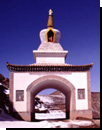 The
"gateway chorten" leads into Xiachong monastery north of
Rebgong (Huangnan), a monastery associated with one of the teachers
of the great Tibetan Buddhist scholar and reformer, Tsongkapa.
This was built (or rebuilt) after 1980. The
"gateway chorten" leads into Xiachong monastery north of
Rebgong (Huangnan), a monastery associated with one of the teachers
of the great Tibetan Buddhist scholar and reformer, Tsongkapa.
This was built (or rebuilt) after 1980. |
|||||||||||
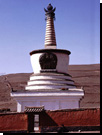 This
chorten was built in 1984 at the Gonlong Gompa (Youning Si), the monastery
in the Hu region of northern Amdo, well to the north of Rebgong (Huangnan).
It was the home monastery of the Zhangjia Hutuktus, the most famous
one of whom was Rolpai Dorje, the 18th century scholar
who advised the Qianlong Emperor in Beijing. Local monks told me this
chorten doesn't have sharira (bodily relics) in it, but generally
commemorates Buddhism. The long-life deity Ushnishavijaya
is placed inside the niche. This
chorten was built in 1984 at the Gonlong Gompa (Youning Si), the monastery
in the Hu region of northern Amdo, well to the north of Rebgong (Huangnan).
It was the home monastery of the Zhangjia Hutuktus, the most famous
one of whom was Rolpai Dorje, the 18th century scholar
who advised the Qianlong Emperor in Beijing. Local monks told me this
chorten doesn't have sharira (bodily relics) in it, but generally
commemorates Buddhism. The long-life deity Ushnishavijaya
is placed inside the niche. |
|||||||||||
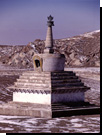 Southwest
of Rongwo is the Nyingma monastery named Hor Terton Yaegar. It is
most famous for the piled wall of slate on which was carved all the
texts of the Tibetan Buddhist canon: the Kangyur and Tengyur. At the
head of the valley, announcing the monastery is this imposing chorten. Southwest
of Rongwo is the Nyingma monastery named Hor Terton Yaegar. It is
most famous for the piled wall of slate on which was carved all the
texts of the Tibetan Buddhist canon: the Kangyur and Tengyur. At the
head of the valley, announcing the monastery is this imposing chorten. |
|||||||||||
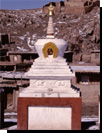 At
Hor Terton Yaegar there is a line of eight chortens. In Buddhism,
there is a convention of eight stupas which each commemorate a different
miraculous episode in the Buddha's life (birth, enlightenment, first
teaching, replication, descent from heaven, taming the elephant, the
gift of honey and parinirvana). Click on the thumbnail at left for
four of the eight chortens. At
Hor Terton Yaegar there is a line of eight chortens. In Buddhism,
there is a convention of eight stupas which each commemorate a different
miraculous episode in the Buddha's life (birth, enlightenment, first
teaching, replication, descent from heaven, taming the elephant, the
gift of honey and parinirvana). Click on the thumbnail at left for
four of the eight chortens. |
|||||||||||
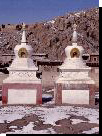 Click on
the thumbnail at left for the other four chortens at Hor Terton
Yaegar. Each of the eight has a slightly different shape and represents a
different place in India or Nepal.The eight chortens are affiliated
with the eight miracles that took place in the following locations:
The Buddha's
birth is associated with Lumbini; the enlightenment
with Bodh Gaya; the first sermon with Sarnath; the miracle of replication
with Shravasti; the descent from heaven with Sankasya; taming the
wild elephant with Rajagriha (Rajgir); the monkey's offering of honey
with Vaishali; and the Mahaparinirvana with Kushinagar.
Click on
the thumbnail at left for the other four chortens at Hor Terton
Yaegar. Each of the eight has a slightly different shape and represents a
different place in India or Nepal.The eight chortens are affiliated
with the eight miracles that took place in the following locations:
The Buddha's
birth is associated with Lumbini; the enlightenment
with Bodh Gaya; the first sermon with Sarnath; the miracle of replication
with Shravasti; the descent from heaven with Sankasya; taming the
wild elephant with Rajagriha (Rajgir); the monkey's offering of honey
with Vaishali; and the Mahaparinirvana with Kushinagar. |
|||||||||||
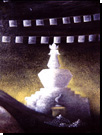 This
is a detail of a painting by two artists who are brothers and living
in Rongwo. The brothers are Dondrup Tsetan (b. 1974) and Lujia Tsering
(b. 1982). It shows a chorten beneath prayer flags. For an
image of the entire painting, click here. This
is a detail of a painting by two artists who are brothers and living
in Rongwo. The brothers are Dondrup Tsetan (b. 1974) and Lujia Tsering
(b. 1982). It shows a chorten beneath prayer flags. For an
image of the entire painting, click here. |
|||||||||||
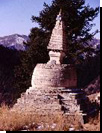 Local
people consider this the Swayambu chorten, the same as the famous
one in Kathmandu. Making a pilgimage to this chorten, northeast
of Rongwo, at the Yamatashi kyil Gompa, is equivalent to going to
Kathmandu. Yamatashi kyil, set atop a hill, is associated with the
famous 18th century Amdo poet and mystic Shabkar. It is also near
the village of Gendun Chopel, the 20th century iconoclast who also
lived at the Gompa for several years. Click here
for another view of the chorten. Local
people consider this the Swayambu chorten, the same as the famous
one in Kathmandu. Making a pilgimage to this chorten, northeast
of Rongwo, at the Yamatashi kyil Gompa, is equivalent to going to
Kathmandu. Yamatashi kyil, set atop a hill, is associated with the
famous 18th century Amdo poet and mystic Shabkar. It is also near
the village of Gendun Chopel, the 20th century iconoclast who also
lived at the Gompa for several years. Click here
for another view of the chorten. |
|||||||||||
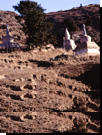 This
is a view of the chortens, including the Swayambu chorten,
at Yamatashi kyil Gompa, northeast of Rongwo. Yamatashi kyil Gompa
is a Nyingma monastery. A beautiful assembly hall built of stone was
destroyed in the Cultural Revolution. Only parts of the walls remain,
though the roof has collapsed. This
is a view of the chortens, including the Swayambu chorten,
at Yamatashi kyil Gompa, northeast of Rongwo. Yamatashi kyil Gompa
is a Nyingma monastery. A beautiful assembly hall built of stone was
destroyed in the Cultural Revolution. Only parts of the walls remain,
though the roof has collapsed. |
|||||||||||
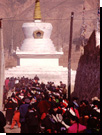 This
chorten stands outside the walls of the Wutun Xia (Sengge
Shong Mango) monastery north of Rongwo. Villagers are circumambulating
the monastery on the annual day of the large applique tangka unrolling,
which in 2002 took place on 19 February. The chorten appears
to be a restoration post 1980. Click here
for another view against blue sky. This
chorten stands outside the walls of the Wutun Xia (Sengge
Shong Mango) monastery north of Rongwo. Villagers are circumambulating
the monastery on the annual day of the large applique tangka unrolling,
which in 2002 took place on 19 February. The chorten appears
to be a restoration post 1980. Click here
for another view against blue sky. |
|||||||||||
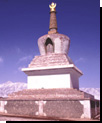 A
chorten standing below Xiachong monastery north of Rebgong.
This monastery is associated with one of Tsongkapa's teachers. Like
the gateway chorten included above, this one was also built
(or rebuilt) after 1980. It is near the residence of a very kindly
incarnate lama named Alak Dempen Trulku. A
chorten standing below Xiachong monastery north of Rebgong.
This monastery is associated with one of Tsongkapa's teachers. Like
the gateway chorten included above, this one was also built
(or rebuilt) after 1980. It is near the residence of a very kindly
incarnate lama named Alak Dempen Trulku. |
|||||||||||
|
|||||||||||
........................................................................................................................................................................................
Images © 2003 Rob Linrothe
Copyright © 2003 Shelly and Donald Rubin Foundation
